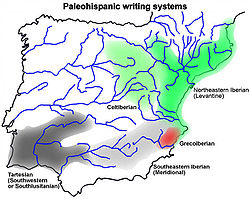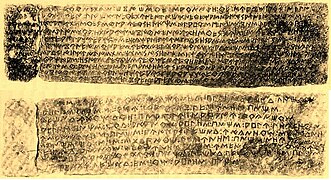Celtiberian script
This article includes a improve this article by introducing more precise citations. (March 2014) ) |



The Celtiberian script is a
Continental Celtic language, which was also occasionally written using the Latin alphabet. This script is a direct adaptation of the northeastern Iberian script, the most frequently used of the Iberian scripts
.
Origins
All the
semi-syllabaries. There is no agreement about how the Paleohispanic semi-syllabaries originated; some researchers conclude that they derive only from the Phoenician alphabet, while others believe the Greek alphabet
was also involved.
Typology and variants
The basic Celtiberian signary contains 26
stops g and d to be differentiated from their respective voiceless
counterparts, k and t, by adding a stroke to the voiceless signs. This is known as the ‘dual system’ in Paleohispanic scripts, which otherwise do not distinguish between pairs of voiceless and voiced stops (p:b, t:d and k:g).
Location of findings
The Celtiberian inscriptions have been found mainly in the
coins, ceramic receptacles, bronze plaques and tesseras, amphores, stones, spindle-whorls, etc.). There are just under two hundred surviving inscriptions, one of which is exceptionally long: the third Botorrita bronze plaque (Zaragoza
) with more than three thousand signs containing a census of nearly 250 people. Almost always the direction of the writing is left to right. The fact that nearly all the Celtiberian inscriptions were found out of archaeological context does not allow a precise chronology to be established, but it seems that the earliest inscriptions in the Celtiberian script date from the 2nd century BCE while the latest ones date from the 1st century BCE.
- Celtiberian inscriptions
-
Cortono plaque. Unknown provenance. Western signary.
-
Luzaga plaque (Guadalajara). Western signary.
-
First Botorrita plaque (Zaragoza). Eastern signary.
-
Another Botorrita plaque (Zaragoza). Eastern signary.
-
Fröhner tessera. Unknown provenance. Eastern signary.
See also
- Celtiberian language
- Greco-Iberian alphabet
- Iberian scripts
- Paleohispanic scripts
- Northeastern Iberian script
- Southeastern Iberian script
- Tartessian script
- Paleohispanic languages
Notes
Bibliography
- Ferrer i Jané, Joan (2005): «Novetats sobre el sistema dual de diferenciació gràfica de les oclusives sordes i sonores», Palaeohispanica 5, pp. 957–982.
- Hoz, Javier de (2005): «La lengua y la escritura celtibéricas», Celtiberos. Tras la estela de Numancia, pp. 417–426.
- Jordán, Carlos (2004): Celtibérico, Zaragoza.
- Jordán, Carlos (2005): «¿Sistema dual de escritura en celtibérico?», Palaeohispanica 5, pp. 1013–1030.
- Rodríguez Ramos, Jesús (1997): «Sobre el origen de la escritura celtibérica», Kalathos 16, pp. 189–197.
- Untermann, Jürgen (1997): Monumenta Linguarum Hispanicarum. IV Die tartessischen, keltiberischen und lusitanischen Inschriften, Wiesbaden.
- Schmoll, Ulrich (1960) : «Die iberischen und keltiberischen Nasalzeichen», KZ 76, 280-295.
- Villar, Francisco (1993): «Las silibantes en celtibérico», Lengua y cultura en la Hispania prerromana, pp. 773–812.
- Villar, Francisco (1995): Estudios de celtibérico y toponimia prerromana, Salamanca.
Further reading
- Blanco, António Bellido, Sobre la escritura entre los Vacceos, in ZEPHYRUS – revista de prehistoria y arqueologia, vol. LXIX, Enero-Junio 2012, Ediciones Universidad Salamanca, pp. 129–147. ISSN 0514-7336
External links
Wikimedia Commons has media related to Celtiberian script.
- The letters of the Celtiberian script
- A transcription of a Botorrita plaque
- Detailed map of the Pre-Roman Peoples of Iberia (around 200 BCE)
- The Celtiberian script - Jesús Rodríguez Ramos
- Ferrer, Joan; Moncunill, Noemí; Velaza, Javier (2015). "Preliminary proposal to encode the north-eastern Iberian script for the UNICODE standard" (PDF).






